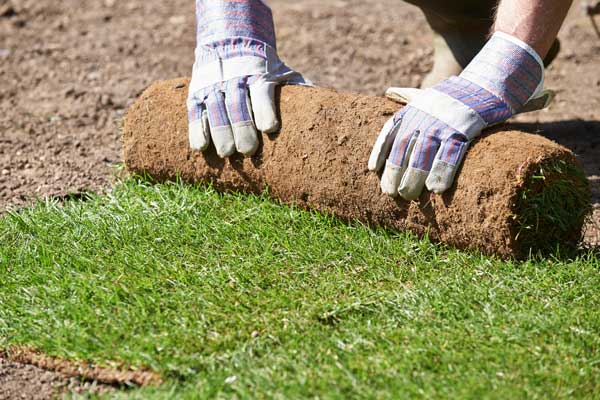If you’re a recent homeowner or you love to garden, weighing up your options for lawn care is very important. You need to figure out your budget, how much time you have, as well as the overall aesthetic appearance you are going for.
So, when it comes to landscaping, it should come as no surprise that picking between sod or hydroseed is a hot topic that gets discussed a lot, especially when it comes to achieving a beautiful lawn.

As the name suggests, hydroseed is a mixture of seed and mulch which gets sprayed over the area in which you want the grass to grow, while sod is an instant lawn that you can install and enjoy immediately.
The method you choose for starting your lawn will influence its health, upkeep requirements, and appearance for many seasons to come and, though both sod and hydroseed can produce a beautiful grassy garden, each comes with its own individual benefits and disadvantages. Read on to learn more about which option is the best for you:
Comparing the features between sod and hydroseed
No matter which option you pick, one thing’s for certain: both are very efficient methods of starting up a grassplot from scratch. However, there are plenty of differentiating features that set the two apart. Here’s a quick rundown between sodding and hydroseeding:
Standout features of sod
- It requires minimal maintenance or upkeep.
- You can roll it out and fit it yourself, while some bigger areas of a yard may require a skid-steer.
- Sod rolls out sort of like a blanket, which means that the likelihood of weeds is lowered because they can’t as easily sprout up between the roots.
- Sod tends to produce more green and vibrant grass as opposed to hydroseed.
- It is often more expensive than hydroseed.
- Sod is better suited to flat areas of land.
- After installing, it takes a few weeks for the roots to grow into the ground.
Standout features of hydroseed
- Hydroseed is cheaper than sod and can be purchased at just about every local hardware store.
- Spreading out a hydroseed mixture is a lot easier than laying sod. It takes only minutes to spray it across your lawn.
- As there is so much variety to purchase, you have a much wider variety of grasses to choose from including bluegrass and St. Augustine.
- Hydroseeding is the best choice for uneven land or lawns.
- The hydroseed method means that the seeds germinate and grow roots that are often stronger and healthier than sod roots.
Comparing the differences between sod and hydroseed
Composition
Sod (sometimes referred to as turf) is instant grass made up of soil and roots that can be ‘rolled out’ while hydroseed is a liquidized mix of mulch, seeds and fertilizer that gets sprayed onto the area you want the grass to grow.
For this reason, sod is installed into a lawn after the grass has already begun to grow (hence the immediate results), although it is worth noting that it does take a little while for the roots to embed themselves in the area of the yard that it has been fitted.
On the other hand, hydroseeding is a little different and is most commonly used in an area where the grass is already growing. The liquid mixture is sprayed onto the area to allow the seeds within the formula to germinate and start to grow.
Preparation process
Even though they are different, both the hydroseed and sod method will require some preparation before installing. For example, you will need to remove old, dry or dead grass, leaves, as well as rocks (especially if you’re planning on going for the sod option as you want the area to be smooth).
Additionally, sometimes you may need to purchase additional soil to properly prepare the ground, although this isn’t always the case and is most common with hydroseed installation.
The ground needs to be in tip-top condition for the hydroseed mixture to be able to germinate, so you’ll need to be prepared to pay more money for new soil if your lawn is looking a little under the weather. For this reason, the preparation process for installing sod is typically a much cheaper and low maintenance option.
The amount of time it takes
The next difference is how long each method will take to create a fully-grown, healthy lawn. If you decide to go for sodding, you’ll achieve a grassy area that will be ready for use as soon as the installation process is completed, although it does take a few weeks for the roots to take to the area.
Hydroseeding takes longer, with the seed and mulch mixture taking anywhere between four-five weeks for the seeds to germinate. While hydroseed doesn't offer the instant lawn of sod, it is a lot faster than traditional lawn seeding. Typically, you begin to see grass begin to grow between 7-10 days.
Maintenance
Another difference between sod and hydroseed is the amount of maintenance both require. With sodding, all you have to do is lay the sod down and it will be good to go. After you’ve installed it, you will need to water and mow it as you would with any lawn.
On the other hand, due to the nature of hydroseeding, this method definitely requires more upkeep than sodding! Before it becomes a fully-grown lawn, you will have to ensure that you have provided the right conditions to allow the seed mixture to germinate. However, much like sodding, once it has successfully grown, all you will need to do to maintain it is water it and mow it.
Health
Another point to bear in mind is how healthy the grass will be in the long run. Generally speaking, hydroseed usually tends to create healthier grass plots because it continues to grow where it first germinated, so there is already a strong root system present.
Though sod produces immediate results, it is grown elsewhere, so there is a chance that it can dry up before the roots are able to grow into the soil, which could lead to unhealthy or dying grass.
Timing
Another differentiating feature to consider is timing. Although you can use either method all throughout the year, both sodding and hydroseeding have better results at particular times of the year. If you plan to sod, the recommended time to do so is anywhere between late spring to late summer, while hydroseeding should be done anytime between March through to October.
Cost
Though the price varies, sod is the more expensive option of the two. On average, it is around 15 cents per square foot for hydroseed and 45 cents per square foot for sod.
Sod is more expensive than hydroseed because it is grass that has already been planted. Therefore, when you purchase sod, you are essentially going to be paying for the expenses and manual labor needed to grow a beautiful, healthy lawn.
Though it is more expensive, it’s extremely convenient! You also won’t have to stress about the curb appeal because the grass will already be vibrant and green the moment you purchase it. Hydroseed is the cheaper option because it requires you to undertake the early life maintenance of the grass yourself.
Although, if you enjoy being out in the garden and you have the time to spare, the hydroseed method can be really enjoyable and rewarding.
Deciding which method to choose
The best and most appropriate method for you all depends on your personal preferences. If you’d like instant results, we recommend sodding because all you need to do is roll it out across the area you’ve selected. On the other hand, if you’re on a budget or live in a particularly hilly area, hydroseeding is probably going to be the best option for you.
Additionally, if you lead a busy lifestyle and don’t have a whole lot of time to spare, sodding is probably going to be the better option because it’s very easy to install and will give you the instant satisfaction of a healthy and vibrant grass garden.
Although, if you do happen to be a gardening fan who wants the satisfaction of being able to say that they grew their own lawn from scratch, then hydroseeding will give you the chance to nurture and grow your garden from start to finish.

